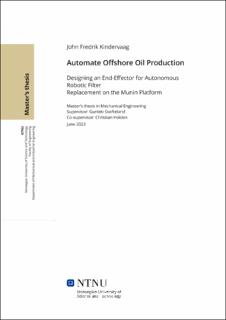| dc.contributor.advisor | Skofteland, Gunleiv | |
| dc.contributor.advisor | Holden, Christian | |
| dc.contributor.author | Kindervaag, John Fredrik | |
| dc.date.accessioned | 2023-10-07T17:20:02Z | |
| dc.date.available | 2023-10-07T17:20:02Z | |
| dc.date.issued | 2023 | |
| dc.identifier | no.ntnu:inspera:146977797:34116750 | |
| dc.identifier.uri | https://hdl.handle.net/11250/3095081 | |
| dc.description.abstract | Denne masteroppgaven presenterer utviklingen og evalueringen av en robotiskgriper designet for å automatisere filterbytteprosessen i et vannfjerningssystem forgassproduksjon. Prosjektet tar for seg utfordringene knyttet til oppgavene medå demontere det mekaniske huset som inneholder filteret, håndtere det delikatefiltermaterialet og sette sammen huset igjen etter filterbyttet. Arbeidet fokusererprimært på design, prototyping, testing og ytelsesanalyse av end-effektoren, samtintegrasjon med en KUKA KR16 industrierrobot.Designprosessen er basert på en grundig analyse av krav og begrensninger, ogtar hensyn til faktorer som oppgaveomgivelsene, tilgjengelig maskinvare, materi-alvalg og komponentutvalg. En iterativ designmetodikk er benyttet, og utnytterCAD-programvare og 3D-printing for rask prototyping og testing av flere desig-niterasjoner. Det endelige designet består av tre hovedkomponenter: hovedhuset,vingemutterforsamlingen og filterhuset, som hver er ansvarlige for spesifikke de-loppgaver i filterbytteprosessen.En analyse basert på elementmetoden utføres for å evaluere strukturell integritetog ytelse av end-effektoren under ulike lastforhold. Programvaren nTopologybrukes for FEM-analysen og for å optimalisere designet for additiv produksjon.Den mekatroniske systemet, bestående av blant annet sensorer og servomotorer,diskuteres også, og detaljerer deres integrasjon og funksjonalitet innenfor end-effektorens design. I tillegg til FEM-analysen, blir end-effektoren også fysisktestet, noe som ytterligere bekrefter dens ytelse og egnethet for den tiltenktebruken.Oppgaven inkluderer en omfattende gjennomgang av prototypingsprosessen, ogfremhever nøkkellærdommer og forbedringer gjort i hver iterasjon. Ytelseseval-uering og analyse diskuteres i detalj, og gir innsikt i end-effektorens effektivitetog potensielle områder for fremtidig utvikling.Avslutningsvis demonstrerer denne masteroppgaven utviklingen av en robotslut-teffektor som fungerer som et proof of concept og viser evner som er nødvendige forå automatisere filterbytteprosessen i et vannfjerningssystem for gassproduksjon.Prosjektet viser bruken av innovative designmetodikker og produksjonsteknikker for å møte komplekse utfordringer i den virkelige verden, og baner vei for yt-terligere fremskritt innen robotikk og automatisering. | |
| dc.description.abstract | This Master’s thesis presents the development and evaluation of a robotic end-effector designed to automate the filter replacement process in a water-removalsystem for gas production. The project addresses the challenges associated withthe intricate tasks of disassembling the mechanical assembly housing the filter,handling the delicate filter material, and reassembling the assembly after filterreplacement. The work primarily focuses on the design, prototyping, testing, andperformance analysis of the end-effector, as well as the integration with a KUKAKR16 industrial robot.The design process is based on a thorough analysis of requirements and con-straints, considering factors such as the task environment, available hardware,material choice, and component selection. An iterative design methodology is em-ployed, utilizing CAD software and 3D printing for rapid prototyping and testingof multiple design iterations. The final design comprises three main components:the main housing, the wing nut assembly, and the filter house, each responsiblefor specific subtasks in the filter replacement process.A Finite Element Method (FEM) analysis is performed to evaluate the structuralintegrity and performance of the end-effector under various load conditions. Thesoftware nTopology is used for the FEM analysis and to optimize the design foradditive manufacturing. The mechatronic system, comprising sensors and servos,is also discussed, detailing their integration and functionality within the end-effector design. In addition to the FEM analysis, the end-effector is also testedin real-life scenarios, further validating its performance and suitability for theintended application.The thesis includes a comprehensive review of the prototyping process, highlight-ing key learnings and improvements made in each iteration. Performance evalua-tion and analysis are discussed in detail, providing insights into the end-effector’seffectiveness and potential areas for future development.In conclusion, this Master’s thesis demonstrates the development of a roboticend-effector serving as a proof of concept and showing capabilities necessary toautomating the filter replacement process in a water-removal system for gas production. The developed end-effector was able to disassemble the mechanical hous-ing, allowing it to reach the filter inside, and replace it with a new one. The projectshowcases the application of innovative design methodologies and manufacturingtechniques to address complex real-world challenges, paving the way for furtheradvancements in the field of robotics and automation. | |
| dc.language | eng | |
| dc.publisher | NTNU | |
| dc.title | Automate Offshore Oil Production - Designing an End-Effector for Autonomous Robotic FilterReplacement on the Munin Platform | |
| dc.type | Master thesis | |
